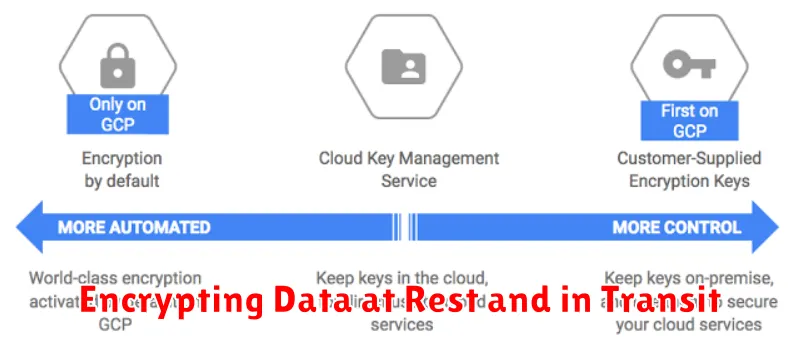In the rapidly evolving digital landscape of 2025, cloud hosting security has become paramount for businesses of all sizes. Leveraging the power of the cloud offers unparalleled scalability and flexibility, but it also introduces unique security challenges. Understanding and implementing best practices for cloud security is no longer optional; it’s a necessity to protect sensitive data, maintain business continuity, and ensure compliance with increasingly stringent regulations. This article will explore the most crucial cloud hosting security best practices for 2025, providing actionable insights to fortify your cloud infrastructure against emerging threats.
From robust access control mechanisms and data encryption techniques to advanced threat detection and incident response strategies, we will delve into the core components of a comprehensive cloud security posture. Whether you are utilizing Infrastructure as a Service (IaaS), Platform as a Service (PaaS), or Software as a Service (SaaS), these best practices will empower you to proactively mitigate risks and safeguard your valuable assets in the cloud. Join us as we navigate the complexities of cloud hosting security in 2025 and equip you with the knowledge to build a resilient and secure cloud environment.
Why Security Is Critical in Cloud Environments
Cloud computing presents numerous advantages, but also introduces unique security challenges. Data breaches, denial-of-service attacks, and insider threats pose significant risks to organizations leveraging cloud services. The shared responsibility model requires a clear understanding of the security obligations of both the cloud provider and the customer.
Protecting sensitive data is paramount. Compliance with industry regulations like GDPR, HIPAA, and PCI DSS is often mandatory, necessitating robust security measures. Failure to comply can result in hefty fines and reputational damage. Data loss can cripple operations and erode customer trust.
System vulnerabilities can be exploited by malicious actors. Regular patching, vulnerability scanning, and penetration testing are crucial for maintaining a strong security posture. Access control is another critical aspect. Implementing strong authentication mechanisms and least privilege principles helps prevent unauthorized access.
Ultimately, strong cloud security is essential for business continuity and success. Investing in robust security measures minimizes risks, ensures compliance, and safeguards valuable data and reputation.
Role-Based Access Controls
Role-Based Access Control (RBAC) is a crucial security practice for cloud hosting environments. It governs access to resources based on assigned roles within an organization, rather than individual user identities. This simplifies administration and enhances security by limiting access to only what’s necessary for a given role.
Implementing RBAC effectively starts with careful planning and definition of roles relevant to your organization’s structure. Assign permissions to these roles based on the principle of least privilege, granting only the minimum access required to perform job duties. Regularly review and update these roles and permissions to reflect changes in responsibilities and organizational structure. This mitigates the risk of unauthorized access and data breaches.
Leveraging cloud provider’s built-in RBAC tools and services simplifies implementation and management. These tools often offer pre-defined roles that can be customized to fit specific needs, streamlining the process and ensuring best practices are followed.
Encrypting Data at Rest and in Transit

Encrypting data, both at rest and in transit, is a fundamental security practice for cloud hosting. Data at rest, residing on storage devices like hard drives or databases, should be encrypted to protect against unauthorized access if a physical breach occurs. Encryption at rest typically employs methods like full-disk encryption or transparent data encryption.
Data in transit refers to data moving across networks, such as between a client and a server, or between different cloud services. Securing data in transit requires using strong encryption protocols like TLS/SSL. This prevents eavesdropping and man-in-the-middle attacks. Validating certificates and using up-to-date encryption ciphers are essential for effective in-transit protection.
Employing robust key management practices is crucial to the effectiveness of encryption. This involves securely storing, rotating, and managing encryption keys. Implementing hardware security modules (HSMs) can further enhance key security by providing tamper-resistant storage and cryptographic processing.
Using Firewalls and Intrusion Detection
Firewalls and intrusion detection systems (IDS) are essential components of a robust cloud security posture. Firewalls act as the first line of defense, controlling network traffic based on predefined rules. They inspect incoming and outgoing packets, blocking unauthorized access to your cloud resources. Modern firewalls can operate at different levels, from the network perimeter to individual instances.
Intrusion Detection Systems (IDS) complement firewalls by monitoring network traffic for malicious activity. They analyze patterns and signatures to identify potential threats, such as port scans, denial-of-service attacks, and malware infections. Upon detection, an IDS can trigger alerts, log the event, or even take automated actions to mitigate the threat. Deploying both network-based and host-based IDS provides comprehensive coverage across your cloud environment.
In 2025, leveraging cloud-native firewall and IDS solutions is crucial. These services integrate seamlessly with cloud platforms, offering scalability, automation, and advanced threat intelligence capabilities. Configuring rules based on specific applications and user roles enhances security without hindering performance. Regular review and updates of firewall rules and IDS signatures are vital to address evolving threats effectively.
Regular Vulnerability Scanning
Regular vulnerability scanning is crucial for maintaining a strong security posture in cloud hosting environments. This proactive approach helps identify and address potential weaknesses before they can be exploited by malicious actors.
Employ both automated vulnerability scanning tools and manual penetration testing. Automated tools offer continuous monitoring and can efficiently detect common vulnerabilities, while manual penetration testing provides a deeper, more nuanced assessment.
Schedule scans frequently, preferably on a weekly or bi-weekly basis, to catch newly discovered vulnerabilities. Prioritize remediation of identified vulnerabilities based on their severity and potential impact. Track and document all scan results for future analysis and compliance reporting.
Consider incorporating dynamic application security testing (DAST) to identify vulnerabilities in running applications. Complement this with static application security testing (SAST) to analyze source code for security flaws during the development process.
Backup and Disaster Recovery Plans

Data backup and disaster recovery are critical aspects of cloud hosting security. A robust backup strategy should include regular, automated backups of all critical data. This includes operating systems, applications, databases, and user files. Backups should be stored in a separate location from the primary production environment to ensure availability in case of a primary site failure. Consider employing the 3-2-1 backup rule: 3 copies of your data, on 2 different media types, with 1 offsite copy.
A comprehensive disaster recovery plan outlines procedures for restoring operations after an unforeseen event. This plan should detail the recovery time objective (RTO), which is the maximum acceptable downtime, and the recovery point objective (RPO), which is the maximum acceptable data loss. Regular testing of the disaster recovery plan is essential to validate its effectiveness and identify any necessary adjustments. This includes simulating different failure scenarios and verifying the ability to restore data and services within the defined RTO and RPO.
Compliance with Industry Standards (GDPR, HIPAA, etc.)
Adhering to industry-specific regulations is paramount for secure cloud hosting. Compliance demonstrates a commitment to data protection and builds trust with clients. Depending on the industry and the type of data being handled, different regulations apply. Some of the most impactful include the General Data Protection Regulation (GDPR), the Health Insurance Portability and Accountability Act (HIPAA), and the Payment Card Industry Data Security Standard (PCI DSS).
Choosing a cloud provider that understands and adheres to these regulations is crucial. Look for providers who offer compliance certifications and demonstrate a clear understanding of your industry’s specific requirements. Ensure your chosen provider offers features like data encryption, access controls, and robust audit trails to facilitate compliance.
Implementing strong data governance policies is also essential. These policies should outline procedures for data handling, storage, and access, and should be regularly reviewed and updated. Remaining informed about evolving compliance requirements within your industry is also crucial for maintaining a secure cloud environment.

